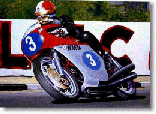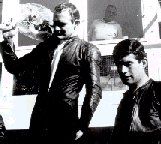
Nearly 20 years later,
John Williams claimed the 110mph record with a lap at 112.27mph on a Suzuki,
and the Isle of Man based Scot, Steve Hislop, edged over the 120mph milestone
with a recorded 120.69mph in 1989 on a Honda.
The reigning fastest man
on the Island is yet another rider from North of the border, Jim Moodie, who
came within a whisker of the 125mph mark last year when he whistled round on a
Honda in 18 minutes and 11.4 seconds, a speed of 124.45mph.
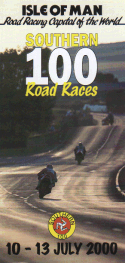
Greeves Motorcycles
Aermacchi
History
The Motorcycle Museum
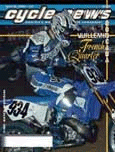






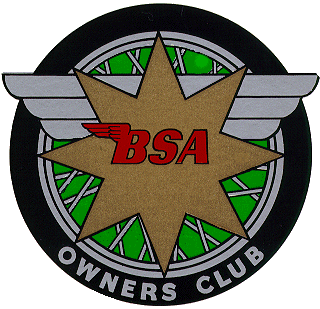
|
|
|
|
|

|
| Brought to you in collaboration with The Department
of Tourism and Leisure
|
Reproduced from August 1965 CycleWorld Magazine.
Since the post-war resumption
of racing in 1947, Geoff Duke won five races and the world car racing champion
John Surtees won six mountain races, with John's three Seniors in a row
(1958-1960) being a record. Mike Hailwood has also won six, including a record
three in one week-the 125, 250, and Senior races in 1961. That's not Mike's
only Island record either, for on his first appearance over there in 1958 he
finished seventh in the 125 race, third in the 250, twelfth in the junior and
thirteenth in the Senior; four races, four replicas, first visit, the only man
ever to have achieved such a feat. He is also the present lap record holder at
106.41 mph.
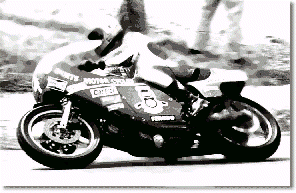
But the king of them all with a
virtually unbeatable record is Stanley Woods who, between 1922 and 1939, won
ten races and set eleven fastest laps. His winning makes were Cotton, Norton,
Guzzi, and Velocette but he also raced Scott, Royal Enfield, New Imperial,
D.K.W. and Husqvarna. Yes, the big V twin of 1934 was a far cry from the
Swedish moto-cross winning machines of the present day.
So much for
the past during which time the races have been run (and still are) by the
Auto-Cycle Union
, controlling body of the sport in England and Wales. To do so they
get a grant from the Manx Government, the equivalent of about forty-two
thousand dollars. This may sound like a lot, but does not go as far as would be
liked when the outgoings are considered. Prize money and cost of awards and
replicas accounts for a fifth of the total and expense grants are made to
overseas competitors.
This is not start money, for if a rider is
injured in practice he can still qualify for something. Police, telephones,
straw bales and the roping off of every turning in the course all have to be
paid for, including two thousand armbands. These include mass groups like five
hundred for marshals, and four hundred for pressmen, down to the select
half-dozen for traveling marshals who are either ex-racers or responsible local
riders with an intimate knowledge of the course and on-off jobs like consultant
chemist and clerk of the course.
The official length of the course is
37.733 miles but no one seems to know how or when this distance was arrived at
as a lot of the A.C.U. records were lost during the war. It was this
uncertainty that prompted the British Weekly,
Motor Cycle
News
, a while back to get Geoff Duke and Charlie Rous measuring the
circuit and their answer was 37.835 miles. However it is measured, it would be
impossible to do so over the racing line and in any event, road improvements
are taking place almost every year. So it looks as if the 37.733 figure will
continue to be used for a while yet. Either distance is a heck of a lot to
Marshall efficiently but Manx folk jealously guard the privilege. There are
forty white-coated flag marshals to be found at specially selected points, and
fifteen telephone stations in addition to the local police and road marshals to
be found at every turning.
Each rider is allowed one pitman on race day
to assist the rider if stopping for any reason. There are no refueling stops in
the 50cc, 125cc and sidecar races run over three laps, but nearly every rider
stops for fuel and a goggle change in the other events. The advantage of
starting with seven gallons on board for the non-stop run is offset by the
handling characteristics for the first couple of laps under such a load. Fuel
stops should not be take more than twenty-five seconds with the gravity-fed
quick fillers set up by the Shell-Mex and B.P. organizations who get up at five
in the morning to have them ready for the races. An efficient pit refuels
during the race against the stop watch, knowing and having checked that the
first gallon takes eight seconds, the second eleven and the third eighteen.
Trade support is a big factor in the races, with many accessory firms
playing vital parts. In 1963, for instance, Shell-Mex and B.P. dispensed eight
thousand imperial gallons of gas during the two weeks of races and, with
Castrol, supplied over eleven hundred gallons of oil. For the statistically
minded, Shell-Mex and B.P. Ltd. have produced a history of the T.T. races in
book form which is published every five years with a supplement in each
intervening year to keep it up to date. But their greatest contribution,
instituted two years ago, is the "Shelicopter" as it has been nick-named. This
is a helicopter held in readiness at the start area, equipped to take two
stretcher cases with doctor and attendants should there be a serious accident
at any inaccessible part of the course.
The fair sex have raced in the
Island and still may do so, but only in the sidecar class as passengers. Mrs.
Beryl Swain is the only one to have raced solo when she competed in the first
50cc race held in 1962. She finished twenty-second on an Itom and so goes down
in T.T. history, for now the rules have changed banning women solo riders from
all International meetings.
What is the riders' attitude toward the
course? An intelligent outlook by many of the also-rans is that it is ideal for
a high speed tour, but all competitors are emphatic that it has to be treated
with the greatest respect. Too often a stone wall will collect the rider whose
exuberance takes him off course. It has to be ridden with not just one but two
or even three bends ahead in mind. This is particularly so in the very tricky
Laurel Bank and Glen Helen sections and the Quarry bends which immediately
precede the Sulby mile. A vital point often overlooked by newcomers is to learn
the way up the mountain. At roughly two-thirds distance Ramsey is reached and
from the famous Parliament Square to the East Mountain Gate the course climbs
some thirteen hundred feet in under six miles. The wrong line or gear through a
corner on this uphill section can be very expensive time-wise. It all boils
down to the fact that you cannot have too much practice and experienced riders
who go back year after year readily admit that they learn something new each
time.
Take 1963 for example; a total of two thousand, eight hundred and
forty-eight laps were covered in the two weeks of official practice and racing.
That is equal to over one hundred and five thousand miles or four times around
the world. All official practice now takes place with the roads closed to all
other traffic and there are heavy penalties for anyone letting animals stray on
the course. If you want to know what it is like to hurtle around a bend on an
MV four at full song and find a cow in the middle of the road, ask John
Surtees, it happened to him once in practice.
Prior to 1928, however,
the roads were not closed and in practice for the 1927 races, Archie Birkin was
killed when he hit a van. The spot is known as Birkin's bend.
|
| Back
|
Next Page
|
|
|
Mann Fact
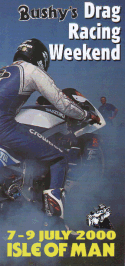



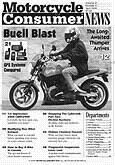
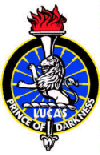
Classic Racing Motorcycle Club



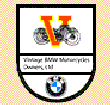
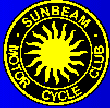


|
|
